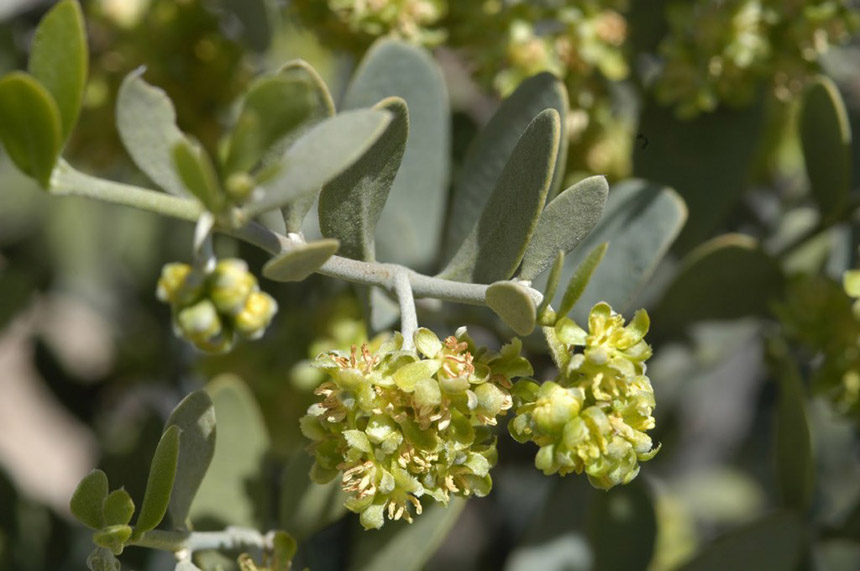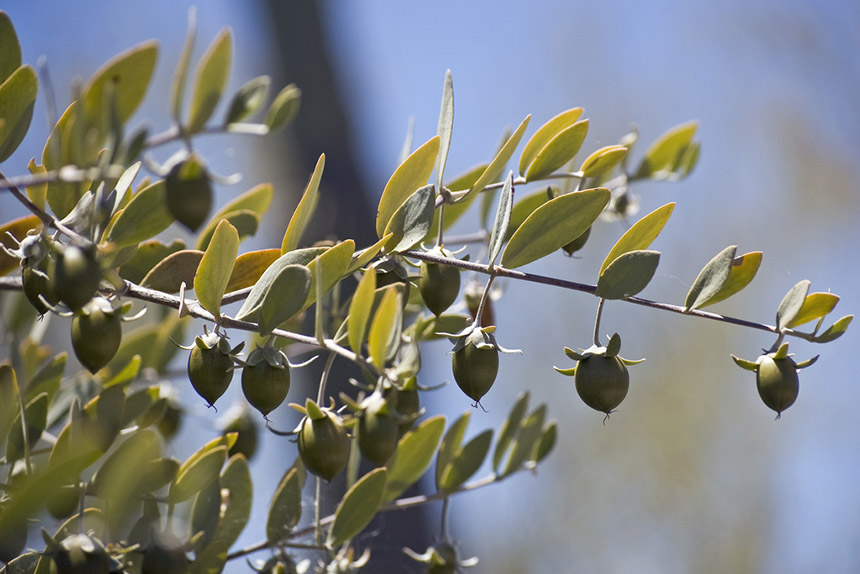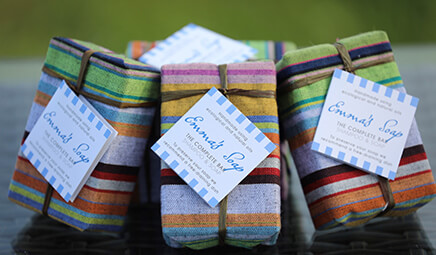The basics
Jojoba Oil, I believe the correct pronunciation is in fact ho-ho-ba, call it how you read it... this oil which is actually a liquid plant wax, is great; from the seed of the Simmondsia Chenensis, the Jojoba plant, a shrub native to southwestern parts of Arizona and California as well as northern Mexico. The plant grows between 3ft and 6ft tall, the crown being dense and broad with oval leaves and a greenish yellow small flower.

There are male and female plants, the male plant pollinating the seed that comes from the female plant transported by wind between February and March. The oil makes up 50% approximately of the Jojoba seed by weight, it takes three years from seed to grow into a plant.

Jojoba plant was first discovered by Native Americans who used it for medicinal properties. The oil’s benefits within the cosmetic industry were later discovered and found to be superior to imported whale oils, particularly of the sperm whale who were hunted to near extinction for its oil until it was outlawed in 971 and a ban on hunting was enforced.

It's properties
Jojoba oil is similar in composition to the oils our skin naturally secretes, from our sebaceous glands we secrete a waxy matter called sebum. Jojoba oil is structurally and chemically very similar to human sebum. The oil works in harmony with sebum, it helps to moisturisers our skin whilst removing sticky build-up of excess oils, keeping our oil levels balanced.
Unrefined jojoba oil (which is the only kind Emma uses) appears as a clear golden liquid at room temperature with a slightly nutty odour. Whereas refined jojoba oil is colourless and odourless.
Jojoba oil is non-toxic, non-comedogenic and non-allergenic which means it will not clog pores and will not cause any allergic reactions. It is an antioxidant and antibacterial.
With beneficial ingredients, vitamin E, vitamin B complex, silicon, chromium, selenium, iodine, copper and zinc
It's uses
Jojoba oil has a staggering number of uses, it practically plays the role of our sebum, there by moisturising the skin and hair when our body stops doing it naturally.
Combination skin: If one produces too much sebum, which often happens during puberty or when hormone levels are high, resulting in oily skin and or acne. Jojoba oil removes the sticky build up of excess oil, it keeps the oil levels in ones skin balanced acting as a protectant and cleanser.
Being rich in iodine, Jojoba oil has antibacterial properties and enable it to fight harmful bacteria growth that can lead to breakouts. Acting as an anti-inflammatory agent, soothing the irritated skin.
Gentle enough to be used on sensitive skin without allergic reactions, it is not an irritant and can safely be used around the eyes and on the skin.
Skin conditions
Jojoba oil regulating sebum production has been shown to aid sufferers of seborrheic dermatitis, dandruff and Psoriasis. Conditions characterised by dry itchy patches, Jojoba oil can clear sebum and dead cell build up by penetrating into the skin, debris can be washed of easily. The anti-inflammatory properties sooth the skin reducing redness and itching, with Vitamin E and B complex both antioxidant have been shown to help fight off free radicals and cell damage, great for maintaining hormone balance, this oil may bring favourable immunological changes.
Hair care
Jojoba oil replenishes and moisture and improves texture of hair, it is suggested to use Jojoba oil to condition hair, aid shine, control fizz and well as detangling the hair.
Dandruff and dry scalp benefit from Jojoba oil by controlling the sebum, the oil gets into the hair follicle and cleanses, dissolving sebum build up, unlocking the follicle and helping new hair to grow aided by anti-fungal properties. The vitamins and minerals in Jojoba oil nourishes the skin improving the health of the scalp
A study from University of Maryland and Medical centre found that Jojoba Oil with a combination of essential oils, Lavender, Rosemary and cedar wood improves hair growth...
Emma’s Complete Bar contains all these ingredients:

